| With the pandemic in the rearview mirror, significant questions face today’s HR leaders, including shaping company cultures among decentralized workforces, reformatting and communicating employee value propositions to meet new employee preferences, and the evolving workplace and its limits. HR Policy Association Chair Pam Kimmet, CHRO at Manulife, kicked off our 2023 CHRO Summit saying, “As we try to navigate these challenges, it’s about sharing—what has worked and what hasn’t worked—so we can continue to move forward.” Read below to find detailed summaries of the essential discussions held throughout our three-day event, held for the first time in four years in Orlando, Florida. | 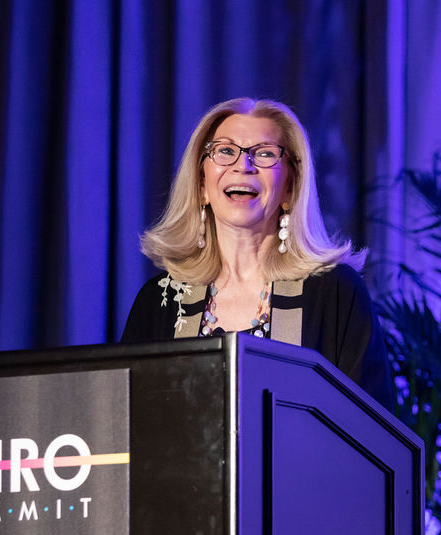 Pamela O. Kimmet Pamela O. Kimmet
|
Scroll below for detailed summaries of the discussions, or click the links to skip ahead.
- The Role of CHROs in Managing the “New” Organizational Culture
- Concurrent Session 1: Is Your Total Value Proposition Evolving and Being Effectively Communicated to the Workforce of the Future?
- Concurrent Session 2: The Evolving Office Workplace—Digital or In Person?
- Concurrent Session 3: The Limits of the “New Workplace” for Deskless Workers
- Concurrent 4: Managing the International Workplace – A Global Perspective on Defining Culture, Workforce, and Productivity
- Making the Transparency Leap: Panel Explores Implications for Talent, Culture, and Pay
- Priya Parker, Author of The Art of Gathering
- Going Beyond Linear: Reflections with Valerie Jarrett
- HRPA Staff Discuss 2023 Public Policy Outlook
- Potential Implications of the Harvard Affirmative Action Case: Are Employer DEI Programs Next?
- What the Gilded Age Can Teach Us About Addressing Today’s Crisis of Democracy
The Role of CHROs in Managing the “New” Organizational Culture
By Gregory Hoff
A panel of CHROs and workforce research experts examined how post-COVID workforce expectations are changing company cultures, how CHROs can help their CEOs change culture to meet workforce and business needs, and how best to engage, develop, and manage talent in the current and future environments. A particular focus was given to the largest growing workforce cohort: Gen Z.
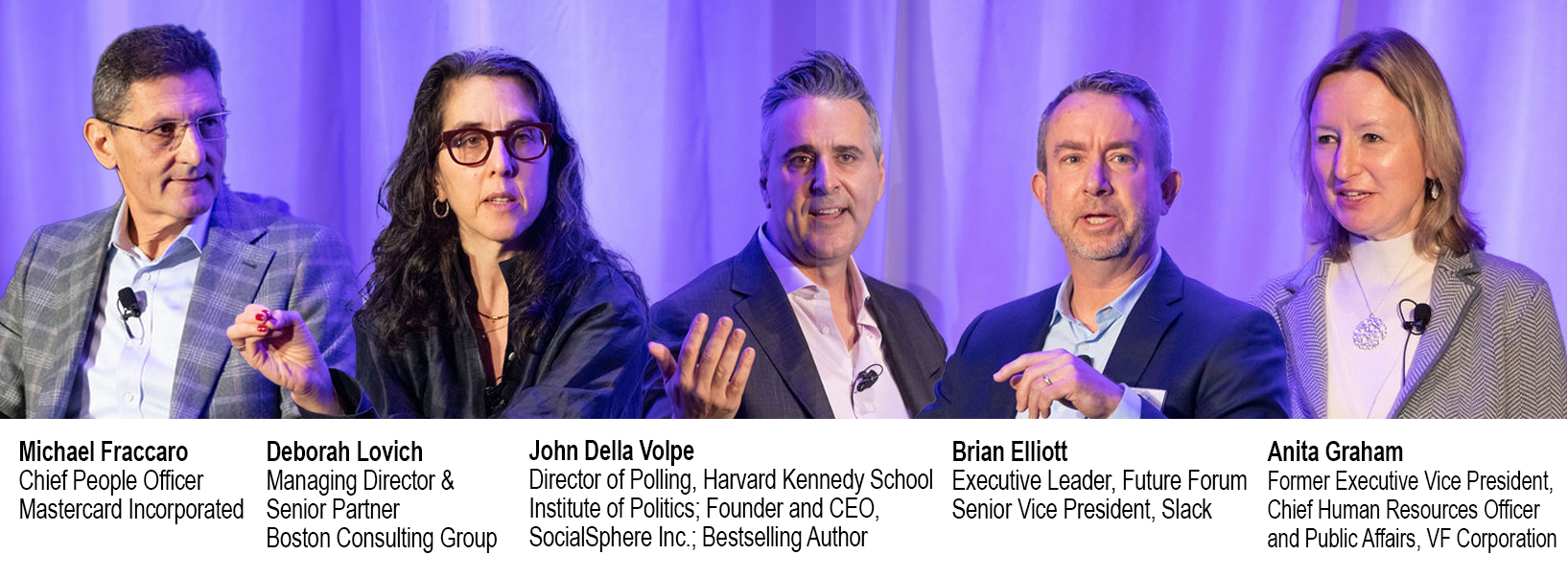
CHROs play a critical role in designing the “new” culture: Moderator Anita Graham emphasized the importance of CHROs to establishing post-COVID workplace cultures and defining new employee value propositions across regions and generations. “As architects of talent we have a unique role in setting the circumstances for embracing cultural changes and maximizing the benefits of a new culture.” Ms. Graham noted that there is a “major experiment in play in how work is done” and that there are both “opportunities and challenges” in implementing flexible work internationally.
Generation of turmoil: John Della Volpe traced several traumatic and defining circumstances that have molded the growth of Generation Z, including the Great Recession, the opioid epidemic, threats to democracy, school shootings, and climate change. Mr. Della Volpe noted that these collective experiences have led to increased rates of anxiety and depression among Gen Z workers, and that the generation as a whole has been robbed of “unifying events” that other generations have experienced. Mr. Della Volpe also discussed Gen Z’s priorities when determining when and where they want to work, and how employers can have better Gen Z outreach, including by simply listening to them.
What about deskless workers? Deborah Lovich discussed the changing priorities and expectations of deskless workers, who, despite getting less focus than desk workers, comprise nearly 80 percent of the workforce. Ms. Lovich emphasized the need to expand the notion of better and more flexible work beyond desk workers, and to focus on “flexibility in time” instead of “flexibility in place.” Broader views on flexibility allow us to “imagine a better, more flexible workplace for our deskless workers.”
Time matters more than place: “If you can constrain typical 8-6 or 9-5 requirements you will increase productivity,” emphasized Brian Elliot, while noting that 93% of surveyed workers wanted flexibility in when they work as opposed to where. Mr. Elliot also noted that flexible work is a "gamechanger for inclusion” because giving more flexibility “boosts a sense of belonging.”
“Trust is the cornerstone of culture:” Michael Fraccaro provided insights into recent efforts at MasterCard to establish a new and flexible post-COVID workplace culture. “The foundation of our culture is the north star in guiding us in the decisions we make about flexibility and productivity.” Mr. Fraccaro also emphasized the importance of trust in building a successful and sustainable culture, noting that “trust is a critical component – we wanted to make sure that all of the value we have created was based on trust.” Panelists further voiced the importance of communicating to employees that flexible work models will continue to evolve and that nothing will ever be a finished product.
Concurrent Session 1: Is Your Total Value Proposition Evolving and Being Effectively Communicated to the Workforce of the Future?
By Daniel Chasen
Mark Wilson, President and CEO of HR Policy’s American Health Policy Institute, led a discussion in which CHROs discussed how they consider culture, pay, and the growing importance of differentiated benefits to address critical changes in the workforce, and how to communicate these differentiated benefits to critical audiences.
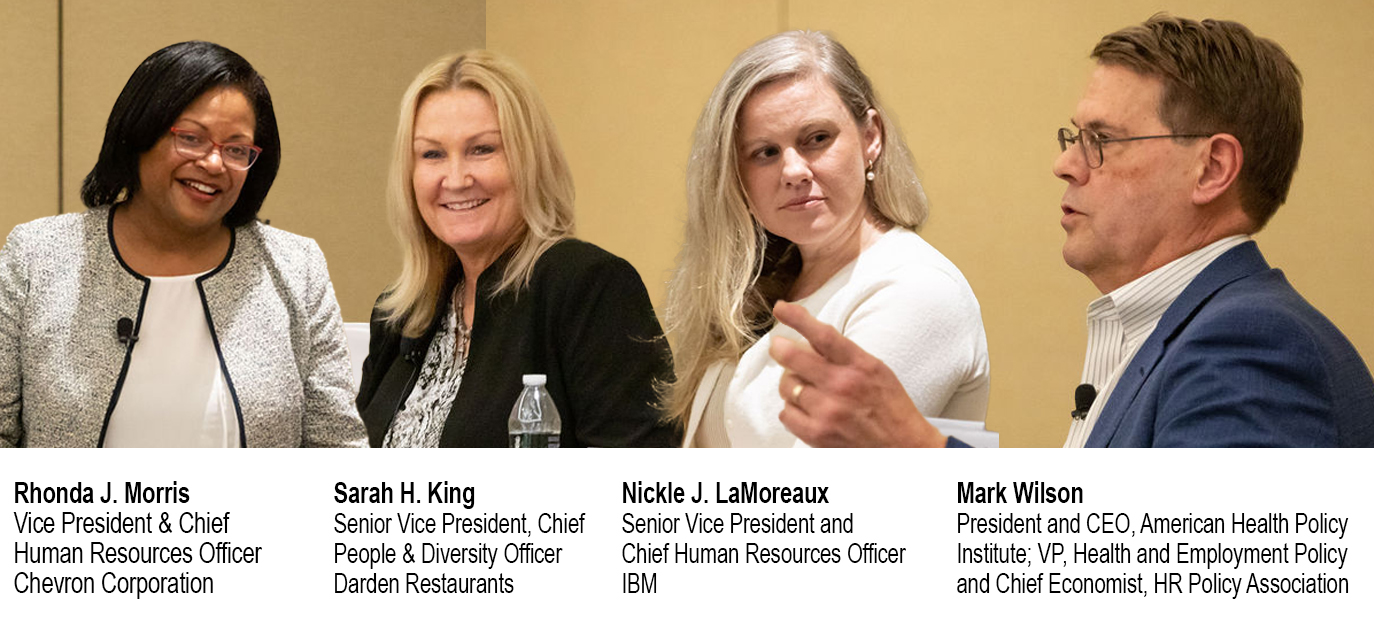
Changes that are prompting responses from companies include a workforce whose composition is rapidly changing as the Baby Boomer generation continues to age out of the workforce, Gen Z becomes a more important part of it, and the U.S. gradually shifts to becoming a majority-minority country. Meanwhile, changes in the regulatory environment, including a more restrictive view of independent contractors, are impacting traditional business talent decisions.
Nickle LaMoreaux described the transition her company underwent going from top-down management prior to the pandemic, to soliciting feedback and feeling obliged to meet all employee preferences, to developing a culture of honest and transparent communication between management and employees where managers communicated with employees what works for the company. Despite not fulfilling all employee preferences, internal communications tools such as Slack, where IBM management engaged in conversations directly with employees on issues such as pay and flexibility, built trust among employees. For example, a new performance management system was designed with feedback from all employees.
The importance of culture was underlined by Rhonda Morris, who related her company’s commitment to hiring people who are particularly collaborative. This approach is reflected in the company’s benefits offerings, which includes a pension plan. Chevron has also instituted internal communications tools that have facilitated organic organization of community groups within the company, from parent resource groups to dog owners. These elements, combined with open and frank communications with employees, have created a culture of trust and community that has supported Chevron’s impressive retention rates.
The arrival of the “Sandwich Generation” – people with care responsibilities for both children and parents – has prompted a rethinking of flexibility, noted Sarah King. The pandemic in particular brought these issues to the surface, and prompted a “fundamental transformation” of the paradigms around flexibility and when work is done. The role of the manager as a builder of trust has also become an important element in recent years, particularly as mental health challenges and other sensitive management issues have emerged.
Concurrent Session 2: The Evolving Office Workplace—Digital or In Person?
By Gregory Hoff
In a concurrent breakout session, Henry Eickelberg and Michele Carlin of the HR Policy staff were joined by CHROs to discuss the ever-evolving workplace and the continued importance of bringing people together in an increasingly digital world.
“Remote work is here to stay:” Panelists discussed the staying power of remote work arrangements, noting that while remote work may decline in the short term, it will continue to increase over a longer period of time. Given this reality, panelists emphasized the importance of addressing the present gap in many companies between leadership and employee expectations regarding workplace flexibility.
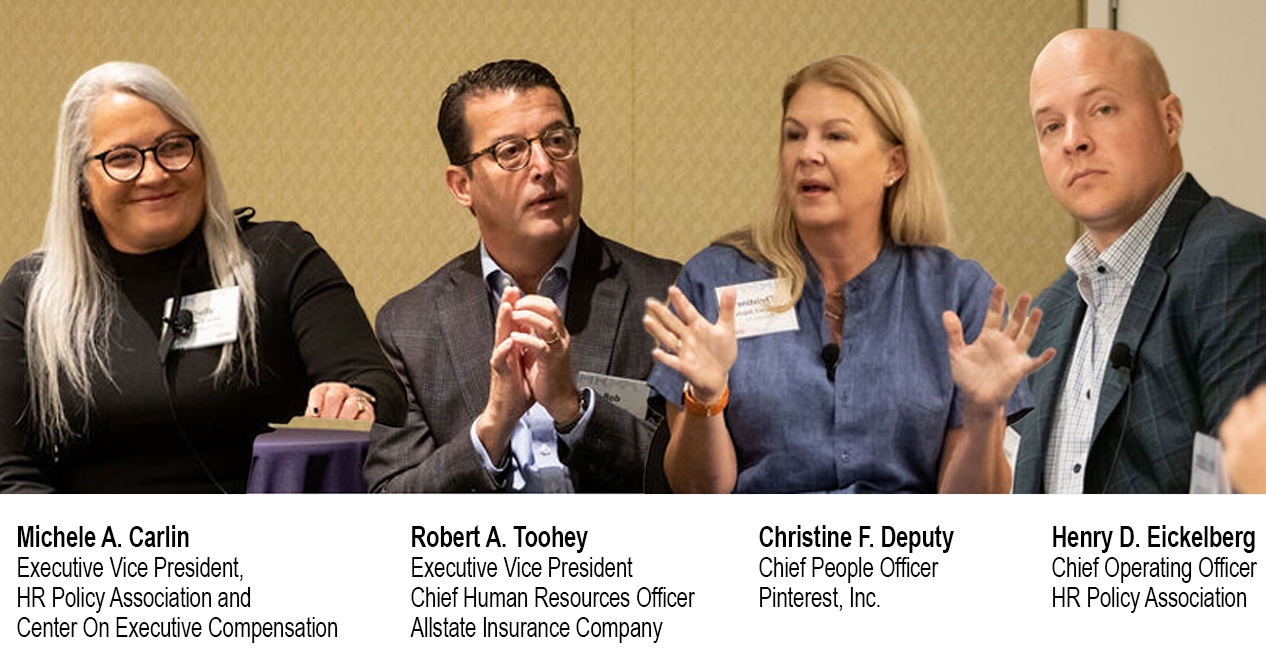
“Let work drive the constructs:” Christine Deputy offered insights into Pinterest’s journey through navigating the flexible work landscape and accommodating both employee and management expectations in doing so. Ms. Deputy noted that allowing how work was actually done to shape how her company developed a flexible work structure gave the process needed direction. “Work is going to define the frequency [of how often teams meet in person].”
“Trust your employees to do the work they have to do, however they do it.” Panelists emphasized the importance of creating trust between management and employees when establishing a flexible work structure. “At the end of the day it’s work anywhere – we have to get rid of the remote and hybrid labels – don’t overcomplicate it,” noted Robert Toohey. Mr. Toohey shared his experiences in helping create new flexible work arrangements at Allstate, and emphasized that despite increased flexibility, it was still important to bring people together for meaningful purposes. Mr. Toohey noted that employees often enjoyed being together in person again, as long as they felt like they weren’t going to be required to resume being in the office five days a week.
Predictability and communication key: Panelists discussed the importance of providing employees predictability regarding when they were expected to come into the office and establishing regular work rhythms as a result. Constant and continuous communication with employees regarding expectations was also emphasized, as it builds reciprocal trust which serves as a foundation for any flexible work model.
Concurrent Session 3: The Limits of the “New Workplace” for Deskless Workers
By Megan Wolf
CHROs discussed how organizations can creatively re-think the work performed by deskless workers to create an environment that allows for increased employee autonomy by empowering leaders to focus on their people.
In a breakout session led by Jacqueline Williams-Roll, , the group highlighted data from the Looking Forward with Gen Z study that indicated 8 out of the top 10 values for work life are related to emotional wellbeing. Feeling valued, meaningful work, and harmony between work and home life were critically important to this generation of workers. The session explored tangible ways to improve the deskless worker experience through empowerment, listening to your people and developing empathetic leaders as well as the challenges that come when remote work is not an option or collective bargaining agreements restrict an employer’s ability to create flexible work schedules and structures.
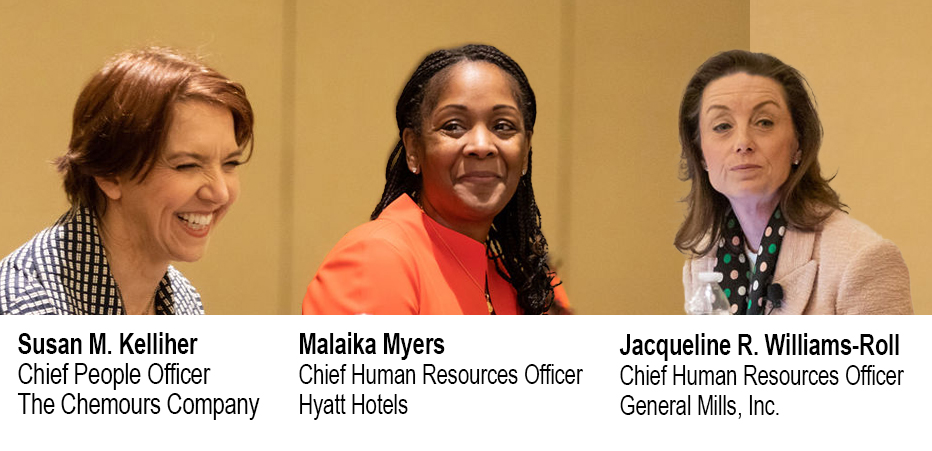
Empowerment as strategy: Ms. Williams-Roll shared how General Mills’ employee-centered approach to operating manufacturing facilities has led to higher engagement, reduced turnover and tripled the number of job applicants. “We provide the framework and trust managers to make the best decisions for their teams. Every location and circumstance is different, so we partner with local leadership to meet their needs.” Every shift begins with a direction-setting meeting where the team lead and team members determine assignments, breaks, and shift “swaps” that employees work out on their own when they need time off. It also includes manager development, nudges and accountability.
Listening and employee choice: Ms. Kelliher remarked, “The three most important things are the same for all employees. Fair pay and benefits, the opportunity to grow and being seen and respected.” She described the importance of taking the time to regularly hear feedback about the benefit programs offered. Focus groups, ERGs, and personal connections with employees has led the company to offer a larger suite of tailored benefits. Increased flexibility has also led to reduced turnover and an increase to the representation of women in their plants.
Leadership focus: Ms. Myers discussed Hyatt’s journey to become a more agile organization and “think differently about how the work gets done.” To do so, “it all comes down to the manager and how they develop competencies to be successful.” Hyatt has renewed its focus on refreshing simplified expectations for leadership that will allow managers to have more decision-making leeway and the ability to try new solutions within their teams, review processes, help employees “clear their plates” to focus on what matters most, and lean into technology. Leaders are experimenting with shorter shifts, four-day work weeks, and one day of remote work per month, which has led to a 30% increase in employees feeling more rested.
Union challenges: The panelists recognized the limitations that collective bargaining agreements have on an employer’s ability to do things differently unilaterally, even if the change is to address a need that the employees are seeking. Sharing data, such as employee survey results, with the local unions can be an effective way to help build support for incremental change.
Ms. Williams-Roll noted today’s leaders “need a higher dose of empathy,” and each CHRO reflected on the importance of leadership development programs and manager engagement and accountability tools to assess effectiveness.
Concurrent 4: Managing the International Workplace – A Global Perspective on Defining Culture, Workforce, and Productivity
By Wenchao Dong
Member company representatives focused on the future of global work shared their perspectives on how CHROs in the U.S. can support a global workforce and manage across cultures, while also discussing what international agencies have been doing to elevate workers’ productivity around the world.
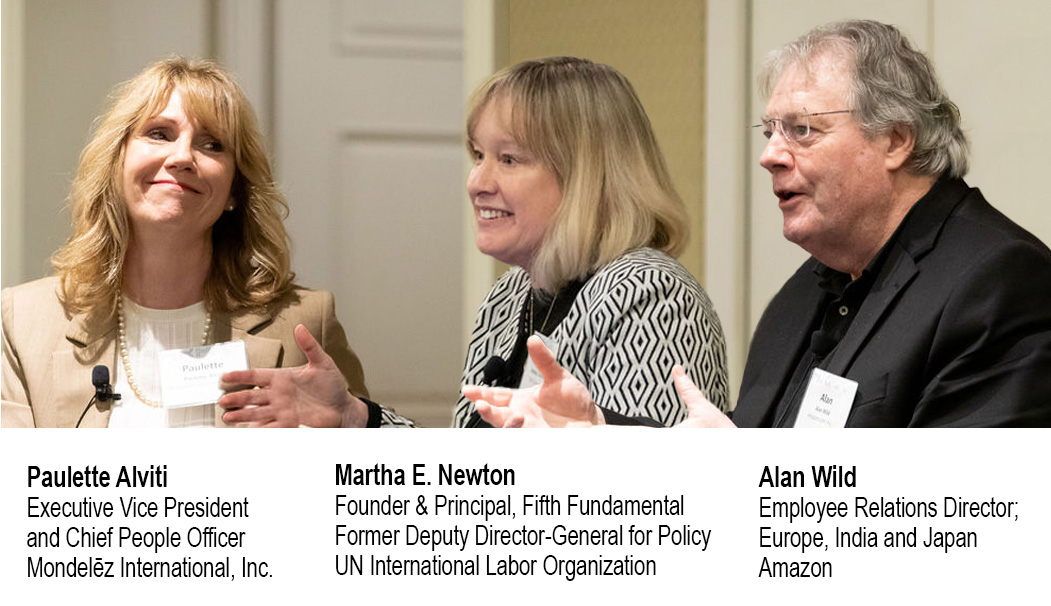
Mr. Wild started the session with a question, “Is your company a multinational company, global company, or ‘colonial’ company?” He then used Erin Meyer’s study “Getting to Si, Ja, Oui, Hai, and Da - How to negotiate across cultures” to explain how to understand and manage different cultures across the world. On that point, Mrs. Alviti shared her guiding principle on managing a globally diverse workforce is “local first but not only.” She noted that companies can have global principles but need to provide local autonomy and avoid trying to apply the same rule across the globe.
On the topic of productivity, Mr. Wild used three examples – the U.S., Germany, and China – to demonstrate how efficiency can look very different depending on where you are. More importantly, to be able to find the model that works for your local workforce is a constant learning process for HR leaders. Ms. Newton mentioned that AI and technology will play an increasingly important role in promoting workers’ productivity, but she expects more regulation in this field in the next few years. Additionally, new regulations currently under consideration could hinder employers’ agility, especially in Europe. Ms. Alviti shared that it is important to educate the team to embrace and keep up with local legislative changes and ensure compliance.
Ms. Alviti shared the challenges of finding good talent and moving them to locations where needed. She emphasized that, unlike before COVID, talent is less willing to move even with promotion and accommodation. Companies should identify talent at early stages when they have more flexibility and build a more diverse talent pipeline. Ms. Alviti used Mondelez’s initiative “General Manager Academy” as an example, where young leaders across the globe go through training and connecting sessions, helping their willingness to grow and move with the company.
The panel noted that the shift of the workforce has fundamentally changed the CHRO’s role when you look at where your key talent, employees, and suppliers are. As COVID brought massive changes to where and how and when people work, the accelerated and widespread use of social media also shifted the way employes express grievances in the workplace. All the changes require leaders to be able to communicate honestly and transparently to the whole organization. Global leaders should build the ability to create an inclusive workplace across multiple cultures and help their employees have a sense of belonging.
Making the Transparency Leap: Panel Explores Implications for Talent, Culture, and Pay
By Megan Wolf
“Transparency is already here, so the question is not whether to be transparent, but how transparent you will be,” Maria Colacurcio, CEO of Syndio, which uses AI to help companies address transparency and pay equity concerns, shared in her initial remarks on a panel focused on the new era of transparency and the implications for CHROs on talent, culture and pay.

Driving factors: State and local legislation aimed at increasing pay equity by requiring salary range disclosure on job postings combined with rising expectations of transparency in general are driving companies to examine their job architecture, pay practices, and communication of their compensation philosophy. While some firms are merely complying with transparency laws where necessary, others are viewing transparency as a benefit and an opportunity to set themselves apart from competitors.
The importance of engaging people leaders: Mr. Massa explained Kroger’s approach to “re-recruiting each associate” and the critical role that managers play. He spoke about how the company “goes to great lengths with people leaders to be able to effectively help employees understand the pay framework, where an employee stands within that framework and why.” He shared Kroger’s pay transparency journey which started over a decade ago with their initial review of pay equity with the board. This year, pay gap data will be disclosed throughout the organization.
Building an employer brand: Mr. Mohiuddin, who co-founded Levels.fyi, a website which aggregates companies pay and level information submitted by individuals, emphasized the importance of transparency to communicate the employer brand and value proposition to younger generations. “You need to communicate the whole package, not just total compensation, but the entire rewards package” and try to quantify the value of employee-friendly programs and policies. He explained why so many job seekers, especially within Gen Z, are willing to share their validated pay data documentation to help other job seekers make educated employment decisions and get the highest total compensation package.
Taking small steps: Ms. Colacurcio discussed the spectrum of pay transparency and how it can be used to “tell a compelling story to employees in a way that builds trust and becomes a competitive advantage from a talent perspective.” She emphasized the importance of using data to guide discretion in making better pay decisions. Ms. Colacurcio gave advice for employers who are not yet ready for full disclosure: start small because there is no going back. “Create a commitment statement of your intent to analyze pay data with a third party. Stay consistent with the initial communication as you move forward. Communicate a plan to get better as soon as you release pay gap data.”
Priya Parker, Author of The Art of Gathering
By Margaret Faso
In a fireside chat, Priya Parker and Ashley Goldsmith tackled a question at the center of the workplace of the future: how do we meet, and who decides?
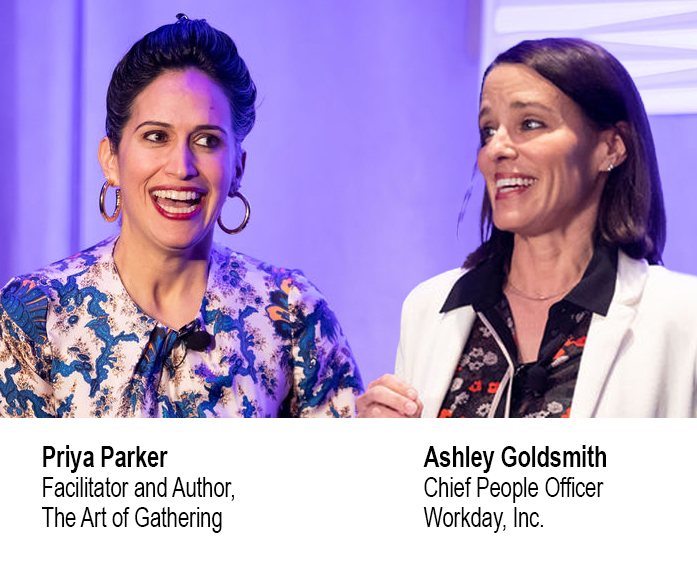
Creating an effective gathering: The biggest mistake organizers make when gathering people together is assuming the purpose is not only obvious, but shared. Drawing on her experience as a child moving between two different cultures, Ms. Parker has always been interested in “when and how we come together and when and how we come apart.” In the workplace, many of our meetings, whether virtual or in-person, are on autopilot and do not meet the needs of the attendees. By centering meetings around a purpose, and clearly communicating that purpose, attendees are less likely to feel their time was wasted.
What is the purpose of this meeting? Getting everyone to ask this question is a great starting point to creating a good experience for employees. Gatherings start at the invitation, not just when the event itself starts. “We tend to under host before everyone arrives,” Ms. Parker noted, continuing that “by not naming things and orienting” attendees, we waste our time. Provide a story with your invitation and give a name to your meeting that allows everyone to understand their role before the meeting starts.
Virtual meetings create a sense of psychological togetherness. The pandemic had a strong impact on the essence of meetings. While in some ways, virtual meetings can improve communication, they also tend to stifle dialogue and candor. In virtual meetings, openings matter—the first five minutes of any gathering disproportionately shapes the remainder of the meeting. Setting aside five minutes at the start of a meeting to allow for informality, or a virtual “coffee line,” can provide the sense of togetherness that many miss from in-person gatherings.
“Part of culture-making is to allow heat,” argued Ms. Parker, noting that allowing heat, or disagreement, is an incredibly important tool for HR leaders. Do not be afraid of specificity or exclusion in your meetings and gatherings. Many organizations are addicted to meetings and when efforts to eliminate meetings are introduced, there can be a sense of feeling left out. Ms. Parker argued that gathering is about exclusion and because our country and companies are so diverse, we have more ways of being and gathering. Attempts at avoiding specific ways of gathering so that people are not offended have made our gatherings and meetings about nothing.
Going Beyond Linear: Reflections with Valerie Jarrett
By Megan Wolf
In a fireside chat with Ms. Jaqueline Welch, Ms. Valerie Jarrett, Senior Advisor to President Barack Obama, shared life stories that influenced her path, shaped her career, and guided her perspective for the future. With messages around “listening to your voice” and “going beyond the linear,” Ms. Jarrett encouraged the audience to find commonality, take risks, and influence change. She provided sage advice for CHROs to use their voice to make a positive impact within their organizational cultures.
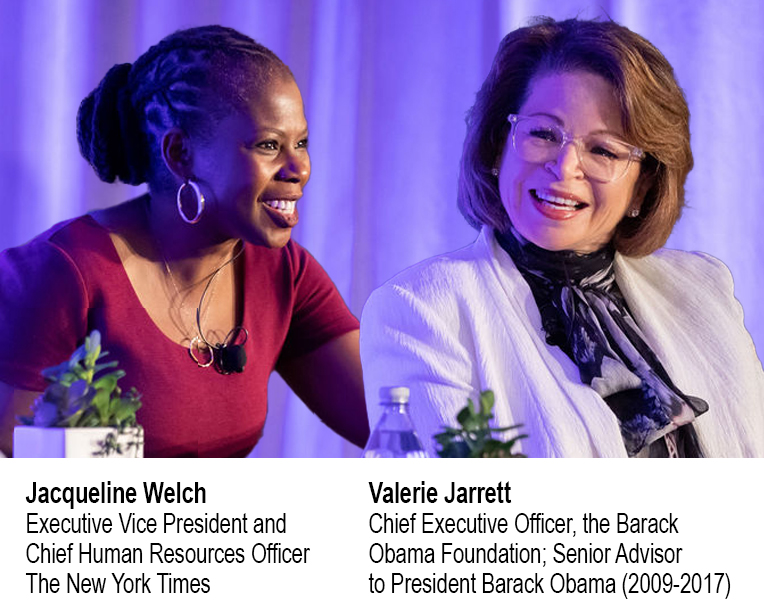
Finding commonality through diversity: Ms. Jarrett noted that being born in Iran and later moving to London and then the U.S. had a profound impact on her views of people and cultures. From an early age, she experienced culture shock leading her “to understand the richness of diversity” and “appreciate the U.S.” after seeing third world countries and the impact of disease. These experiences allowed her to feel she could “find something in common with anyone” and she was always interested in finding out what that something was.
Listening to your voice. Working for a Chicago law firm as a single mother proved to be a very difficult experience, Ms. Jarrett recalled. She spoke about “trying to have it all at the same time” in balancing her career as an attorney and being a mother and expressed fear that talking about being pregnant or being a mother would diminish the seriousness of her as a professional. Through this time, Ms. Jarrett talked about how she had to listen closely to her inner voice to be able to make the decision to leave the law firm and start a new path.
Taking risks: Ms. Jarrett reflected on the significance of taking the risk to move into Chicago politics and how this continued to shape her experiences, including meeting Michelle and Barack Obama. From her own personal situation as a working mother, she acknowledged that “taking risks was easier to do with a safety net” like she was fortunate to have. In politics, she focused on how she could change policies to assist working families who do not have this safety net.
Influencing change: Serving as an advisor to the former President, and leadership positions for numerous boards, Ms. Jarret told stories about how she used her voice to make connections, shape an inclusive culture, propel teams from having “the best players to the best team” and influence people in positions of power. She spoke directly to CHROs to acknowledge the difficult and important role they had as “eyes and ears” of a culture and using their voice with the CEO and leaders to influence change.
HRPA Staff Discuss 2023 Public Policy Outlook
By Wenchao Dong
HR Policy staff provided key legislative and regulatory updates on the most important issues to employers, including ESG, health care, non-compete ban, labor and employment, immigration, and data privacy and AI. The panel focused on the significant implications of these changes for employers and the Association’s advocacy and practice agenda.

Ms. Birbal shared that, while there are some opportunities for legislative compromise on certain targeted issues, due to a split Congress, we are expecting more agency regulations under the Biden Administration’s whole government approach.
- ESG will be a heated topic between blue and red states as Republican lawmakers move to pursue anti-ESG legislative proposals when shareholder proposals favoring ESG approaches and disclosure are increasing.
- Increasing regulations and actions are expected from multiple agencies with limited knowledge of and interaction with labor and employment policy issues, which will have implications for employers. Companies might have to change their policy and practice to comply with the new rules and be called before Congress for hearing over various issues.
- The association will continue to develop relationships with new agencies and advocate for the members.
Ms. Faso stated that affordability and out-of-pocket costs will be a focus for this Congress. Specifically, Sen. Bernie Sanders (I-VT), Chair of the Senate Health, Education, Labor, and Pensions Committee, will use access and affordability to scrutinize employer-sponsored health care benefits. Drug prices, access to health care services flexibility, and mental health legislation and guidance are also on the government’s agenda. Additionally, the upcoming Department of Labor report to Congress on mental health parity violations and increasing drug prices due to Medicare drug pricing negotiations pose risks to employers.. Employers should also expect calls to defend their offerings on Capitol Hill.
On the discussion of Federal Trade Commission’s proposed blanket non-compete ban, Ms. Huang shared that the Association will submit formal comments to the Commission, which has shown some signs of willingness to consider exceptions to the proposed total ban. Additionally, besides the FTC proposal, we have seen increasing partisan appetite and interests on this topic and expect legislative proposals to be introduced.
Mr. Hoff commented, “The NLRB, and in particular its General Counsel, are operating under the premise that any employees not represented by a union are inherently being taken advantage of.” Mr. Hoff also shared that in addition to Board decisions that have already taken place returning to Obama-era labor policies, restrictions on workplace rules, regulations on independent contractors, and changes over arbitration agreements are on the horizon.
Mr. Chasen noted ample state activity to pass comprehensive privacy legislation, with five states already having enacted such measures and similar proposals having been put forward in 20 states and counting. Additionally, multiple agencies are focused on HR technology tools as they consider regulating AI. Employers should also be aware of the possibility of conflicting and overlapping legislation in this regard.
Potential Implications of the Harvard Affirmative Action Case: Are Employer DEI Programs Next?
By Gregory Hoff
The upcoming Supreme Court decision in the Harvard and University of North Carolina affirmative action cases could have ripple effects beyond higher education and into the workplace. A panel of legal experts and CHROs moderated by David Fortney, Co-founder, Fortney & Scott, LLC, examined the potential impacts of the Supreme Court’s decision on diverse talent acquisition as well as employer diversity, equity, and inclusion initiatives.

“Profound implications for workforce development:” Christy Pambianchi emphasized that a decision banning affirmative action programs in higher education could make the existing imbalance in access to colleges and universities worse and correspondingly inhibit employers’ abilities to foster diverse talent. Ms. Pambianchi noted that companies use college campuses as a pipeline for diverse talent and that a negative outcome at the Supreme Court will increase already existing efforts to expand recruiting and outreach to better reach such talent.
Employer DEI programs next? Eric Dreiband noted that many boutique law firms and nonprofit organizations are preparing or already initiating challenges to employer diversity programs in the wake of the Supreme Court’s upcoming decision. Sharon Masling discussed the balancing act facing employers involving the risk of litigation on the one hand and the reputational and business risks associated with a lack of diversity on the other hand. Ms. Pambianchi noted that employers are not going to stop implementing DEI plans: “As long as we have good faith efforts to hire the most qualified candidates, that is going to continue – diversity sourcing is going to continue. Our work in this space is not done.”
“Now is the time to prepare:” Ms. Masling noted that companies should start conducting inventories of their DEI programs and work with their legal teams to assess potential risk, as well as identify risk tolerance levels with senior leadership and the board. “Start thinking now about a communications plan and messaging because there will be a lot of conversations,” said Ms. Masling. Mr. Dreiband emphasized that no matter what happens with the Harvard case, there will be lawful employer DEI programs that will survive legal challenges.
What the Gilded Age Can Teach Us About Addressing Today’s Crisis of Democracy
By Margaret Faso
Drawing on lessons from the Gilded Age and other periods of American history, Mr. Grinspan joined Tim Bartl in a conversation on politics, democracy, and the role employers can play in providing a sense of community and stabilization in an otherwise chaotic time.
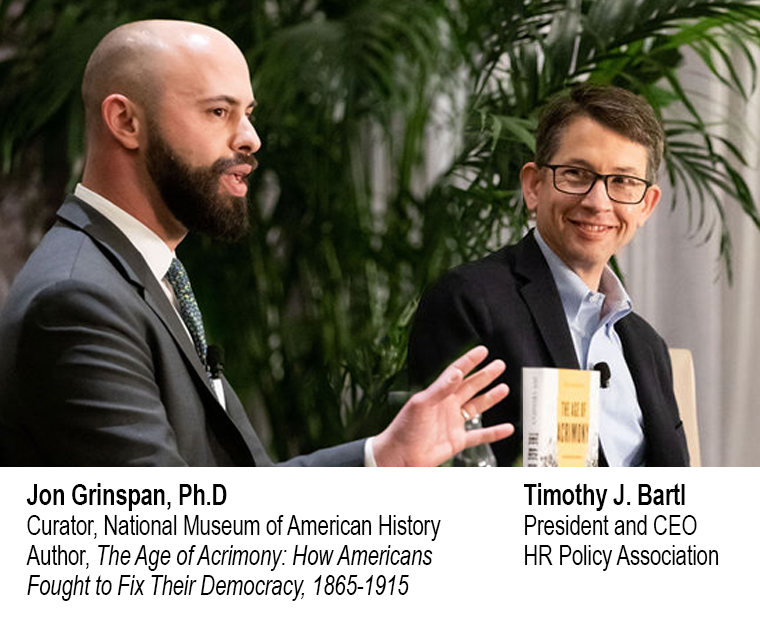
Nervous people make nasty politics: Comparing 19th and 20th century experiences to today’s political disruption, Mr. Grinspan noted that at the time of the Gilded Age, people were experiencing considerable changes in how people live in communities—many left behind their community and traditions in their home countries and became isolated. Isolation led people to seek out anchors in their life and for many, the political system became a very strong anchor for those in need of community. While civic engagement is positive, the tribalism that tends to follow increased civic engagement means that many only care about “winning,” causing the other side to always be seen as an enemy of sorts.
The first step to reform is recognizing a problem at mass scale: A common feeling that things are broken can motivate and drive large groups of people to want to fix whatever is broken. Millennials and Gen Z are two groups that are starting with the assumption that our politics are broken and need fixing. Mr. Grinspan noted that while divisiveness can seem to lead to gridlock in Washington, in many ways it is the starting point to significant change driven by an evolvingculture.
Work can be a stabilizing force in a time of disruption: Mr. Grinspan closed by arguing that work and company culture can play an important role in democracy by providing a key anchor for people. In fact, the rise of associations and other workplace groups occurred during the 20th century when political activity was low and people were looking for something else to anchor them. By playing a stabilizing role in people’s lives, work can provide a sense of community and remove the anxieties that often create tribalism and chaos in politics.
Published on:
Topics: